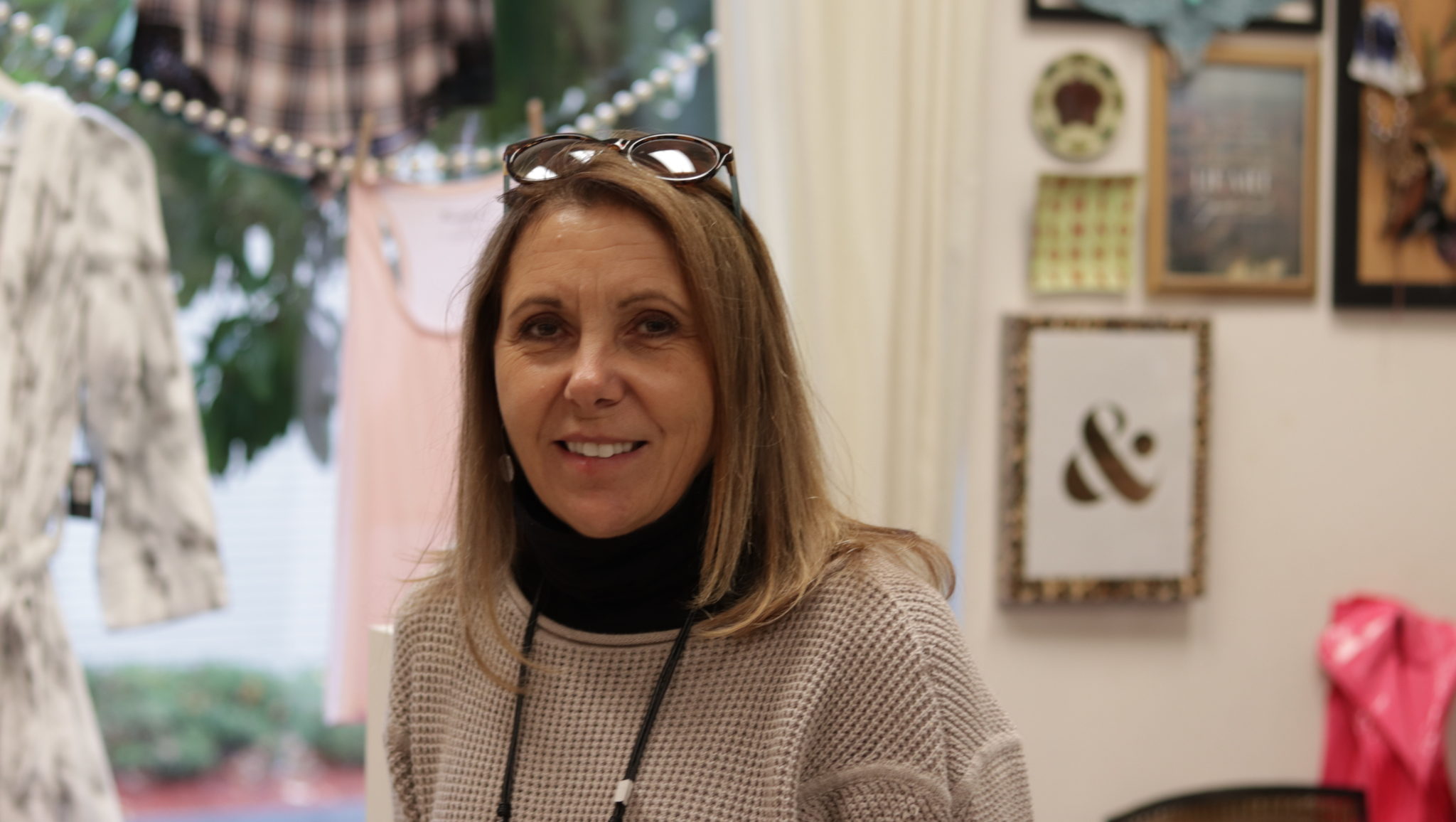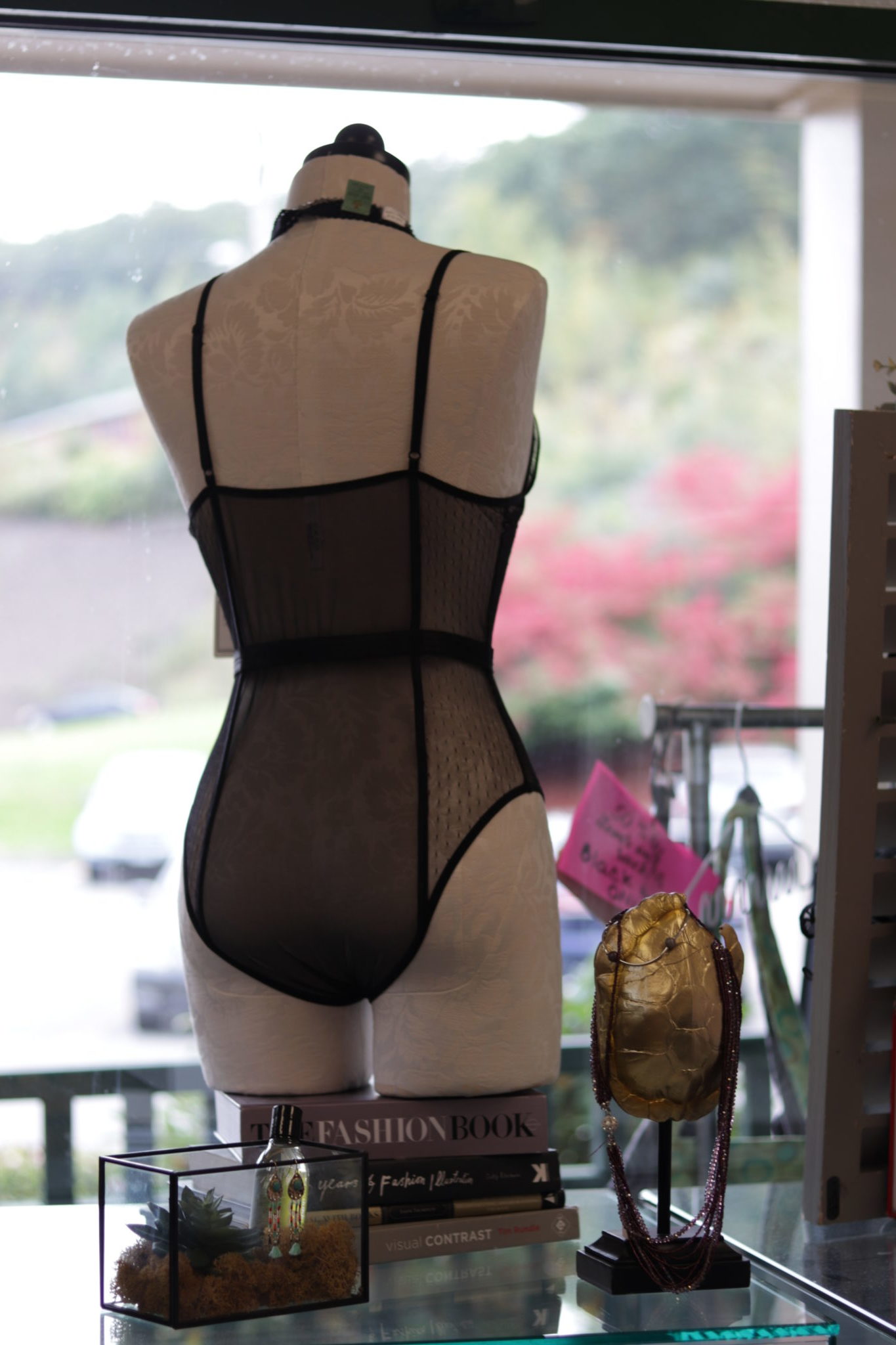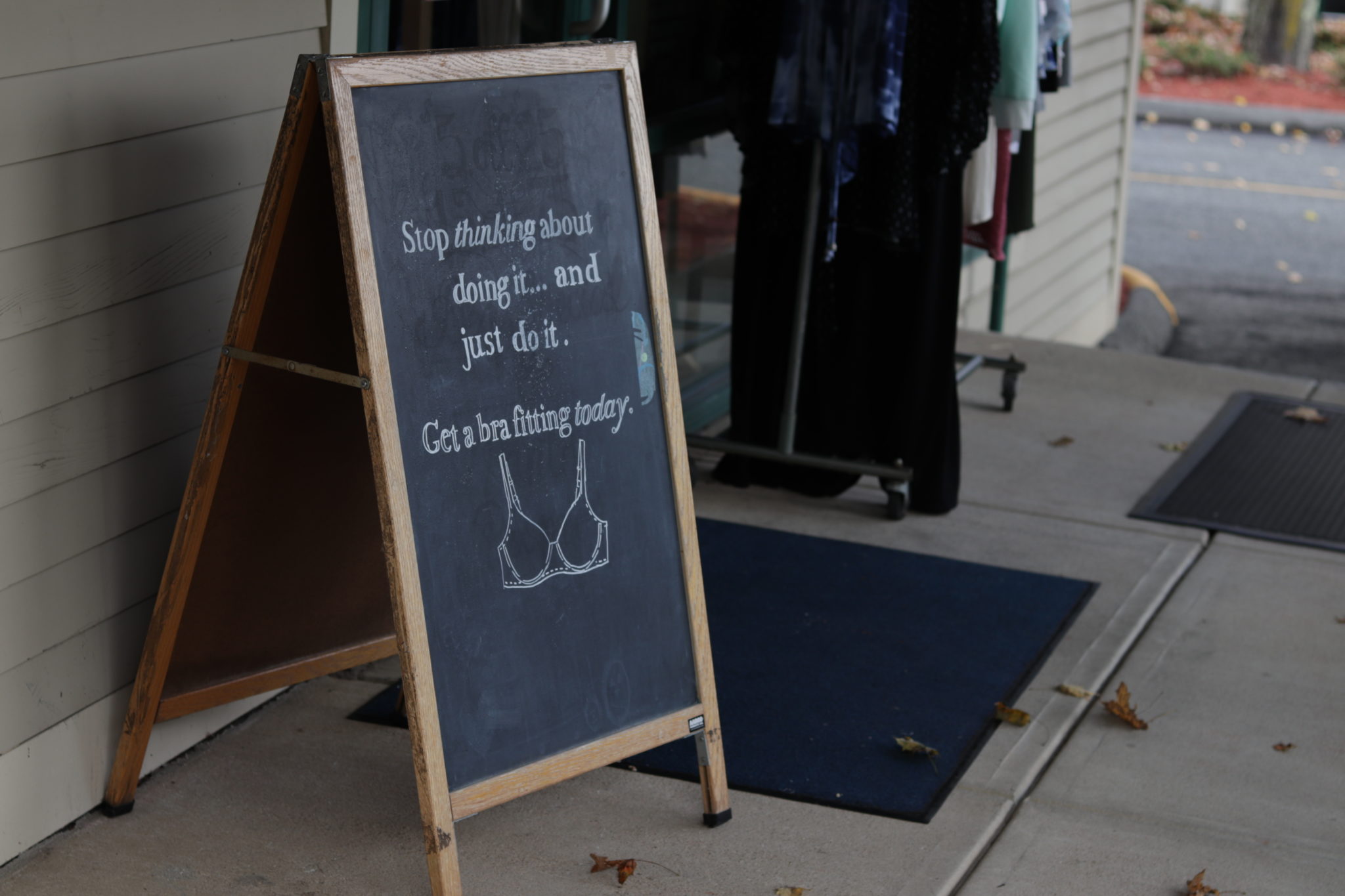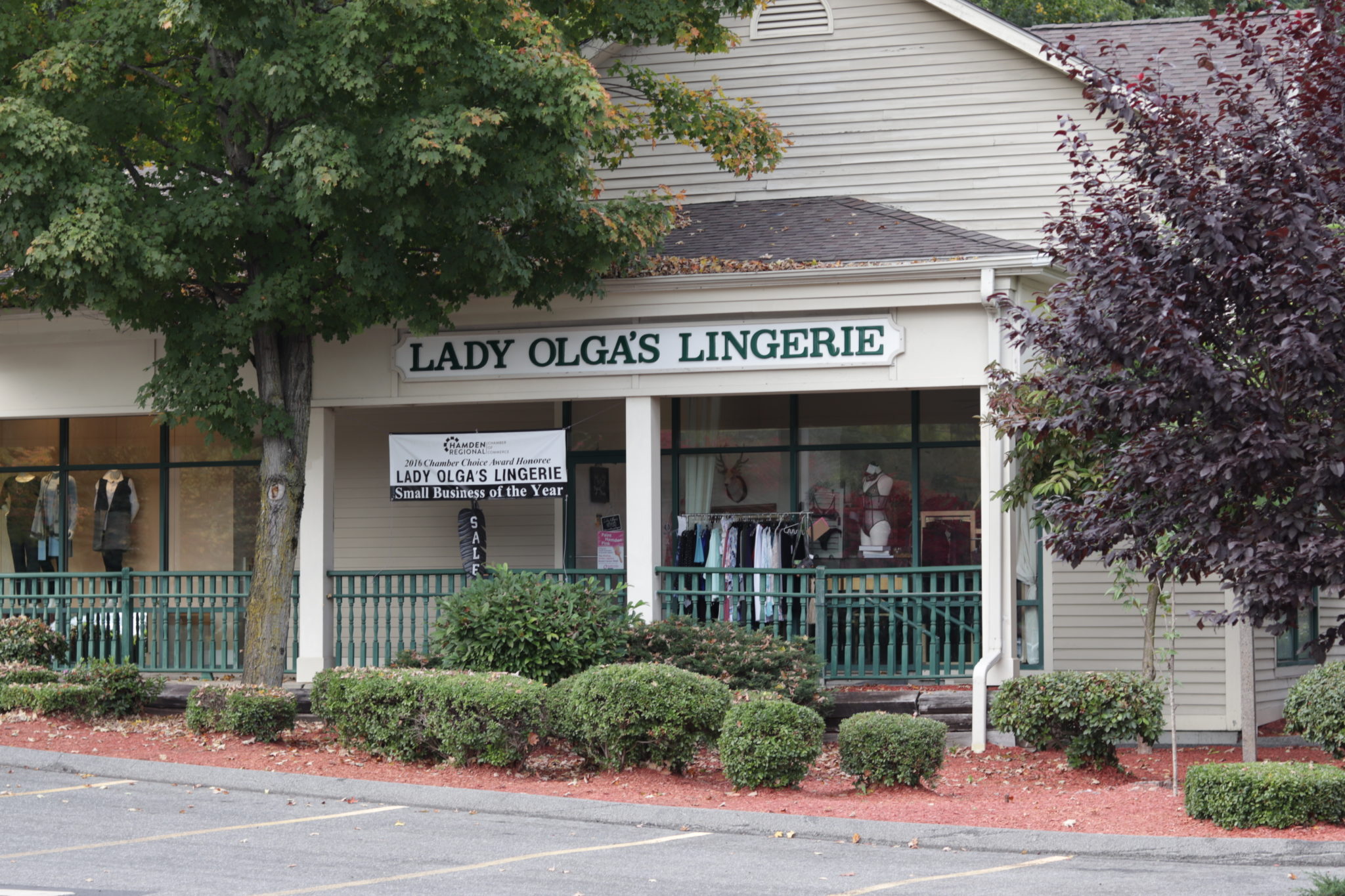
Mariah Kreutter
Jeniene Ferguson looks like she’s about a 36B, give or take a cup size. I’m not the first person to try and guess. Her male customers, shopping for their wives, often attempt the same mental arithmetic. “I ask, ‘What size do you think she is?’ ‘Oh, she’s your size,’” Jeniene mimicked, putting on a deadbeat-sitcom-husband voice as she acts out the scene. “‘My size? Okay.’” That “okay” — which Jeniene uttered with her eyebrows furrowed, her hands raised in defense against the assault of male cluelessness, the emphasis flat across the two syllables — dripped with sarcasm. “And the bra comes back, because turns out she’s a 34A or a 42D.” She rolled her eyes. She knew it would.
Jeniene is the owner of Lady Olga’s Lingerie in Hamden, Connecticut, and there’s very little she doesn’t know about bras. She’s been in the business since 1987, when she and her mother (the eponymous Olga) opened the store together. It’s a small space, nestled in a tiny strip mall. The walls are bedecked with lace and satin and capital-D Decor, like the sculptural white deer head at the entrance. When I visited around Halloween, he was wearing a festive pink half mask, which matched the pink jack-o’-lantern on the table beneath him.
Such kitsch proliferates. A purple beaded necklace hangs from a golden turtle shell above a display of casual loungewear; a pillow emblazoned with “Live Love Laugh” perks up the bridal alcove, which is as soft and white as the idea of a cloud. The plus-size bras occupy a section in the back corner, where each M- or N-cup nestles gently against the canyon of another. (When I saw a 42M for the first time, I almost gasped. It was, definitively, the largest bra I’d ever seen, and it was disorienting, like seeing a moose walk past a Mini Cooper.)
Dull fluorescent panel lights, the kind you’d find in an office or a public school, illuminate the hyperfeminine jewel box below. There is no dimly erotic mood lighting, and no supermodels leer sexily at you from blown-up photos on the walls. Sensuality is present, but it’s obscured by practicality. The male gaze is nowhere to be found. The whole store has a muted and mature sassiness, like a Maxine cartoon come to life: One customer called out, as she was paying, “Jeniene, I know it’s only October, but I think we should plan a getaway this winter. No men.” The women of Lady Olga’s, you imagine, aren’t so concerned with pleasing men as they are with enduring them.
Tucked in a corner near a rickety spiral staircase are the fitting rooms, each outfitted with a full-length mirror and a zebra-print chair. This is fairly typical for a lingerie boutique. Less typical are the signs that read “Protocol for resolving complaints from insurance beneficiaries.” But then typical lingerie stores don’t carry a durable medical equipment designation. Typical lingerie stores don’t have a backroom stacked, floor to ceiling, with prosthetic breast forms. And typical lingerie stores hardly carry bras through size 52O. Lady Olga’s, hail Mary, is not typical.
—
“The original Lady Olga,” as Jeniene often calls her mother, was a corsetiere. A photo of her — robustly plump, with a quizzical brow, a wide smile, and a huge ring on her right pinky — is proudly displayed in the bridal alcove. Olga worked in the foundation garment retail industry for decades, focusing on custom-made girdles, back braces, and other orthotic supports. (Foundation garments are basically lingerie, but the kind that needs as much structural engineering as a girder bridge.) By 1987, Jeniene, then working as a paralegal, just wanted to be her own boss. A lingerie store seemed as good an idea as any. She had to talk her mom out of retirement.
“The only way she’d get into it,” Jeniene told me as we sat on a leopard-print cushioned bench, accessorized with purple embroidered pillows and cream-colored legs in the style of Ionic columns, “was if it was foundations, and for plus-size women. Because they were the forgotten woman.” She looked at me sternly, like I might be guilty of forgetting plus-size women myself.
Founded with that ethos, Lady Olga’s Lingerie continues to offer a size range unheard of in most mainstream retailers. Olga kept doing custom-made work and orthotics until she passed away in 1993. Jeniene, buoyed by a desire to give breast cancer survivors “someplace special” to come, learned how to fit women for post-mastectomy prosthetics. “I wanted it to be a woman’s business,” she explained.
Breast cancer survivors who’ve had mastectomies but not reconstructive surgery can use silicone prosthetics to recreate a body they recognize. These prosthetics are medical-grade, and they’re expensive. That’s where the floor-to-ceiling boxes in the back come in. Mastectomy patients with good insurance are entitled to one new set of breast forms a year. Mastectomy patients with bad insurance, or with no insurance, are not legally entitled to any. Over the years, the well-insured have left their old prosthetics with Jeniene, who examines them, discards the torn ones, catalogues them by size, and stores them. When uninsured, low-income women come in looking for breast forms, Jeniene gives away the used ones for free.
Cross-dressers — of whom the original Olga apparently had “a following” — also come to Lady Olga’s for realistic breast forms and properly fitting lingerie, since bras with wide bands and small cups can be especially hard to find. (Their numbers have dwindled since the rise of online shopping and its unrivalled discretion.) Jeniene has also fit at least two transgender women preparing for reassignment surgery. Over the years, she’s given away a number of donated breast forms to her trans and gender-nonconforming clients as well.
“I have no problem taking care of anyone, or helping anyone — just be honest with me,” she said, when I asked her what it’s like fitting transfeminine clients. “Don’t say it’s for the grandmother in the convalescent home in Danvers, Massachusetts. … No. Tell me it’s for you, I’m happy to help you, and you’ll leave here with the right size.”
Jeniene herself is slim and sharp. Her deep-set eyes are ringed equally with laugh lines and dark circles. She has tawny, shoulder-length hair and favors simple, flattering clothes accessorized with large statement necklaces. Like Laurie Metcalf in Lady Bird, she’s both warm and a little bit scary; her Italian-American drawl can be as cutting as it is welcoming. She peppers her speech with miniature theater productions, imitating moronic husbands, elderly customers, and Quinnipiac sorority girls with universal dramatic aplomb. She talks with her hands and, on occasion, her entire body. When she expresses disagreement, she expresses it vehemently. I asked her how she fits her customers, and she emphasized the importance of being in the fitting room with them: “Even if I did hand the bra in, they’d put the bra on, and they’d just put the bra on. And they’d stand there. Yeah. Nope. Uh-uh. Noooo. No. You have to shake yourself in, lift yourself up, get the nipples in the center of the cup.” By way of demonstration, she bent at the waist and did a little shoulder shimmy ripe with Fun Mom energy. “If you didn’t want anyone in the dressing room with you, why did you come here? You can fit yourself at Kohl’s or Macy’s,” she said.
—

I first learned how to fit myself for a bra the same way so many American girls have over the past 20 years: from The Care and Keeping of You, an illustrated book about puberty published by, well, American Girl, that maker of high-end and higher-maintenance plastic dolls. To my 10-year-old self, the method taught seemed as arbitrary and inscrutable as algebra. We were instructed to measure around our rib cages, then inexplicably add five, then round it to the nearest even number. That, apparently, was your band size. Then you measured around the fullest part of your breasts and subtracted the band size number from whatever you got doing that, and the difference told you your cup size: A one-inch difference was an A, two inches a B, and so on through five inches, which meant a DD. (Anything beyond five inches was unheard of in the American Girl universe.) You put those two things together to get your size: a 32A, a 36C. I soon made sense of algebra. I never made any sense of bra fitting.
The American Girl sizing scheme goes as far as a DD; Victoria’s Secret, the largest lingerie retailer in America and a staple of middle-school locker rooms, carries up to a 40DDD. You’d be forgiven for thinking that’s where breast size tops out. And so, when I started eighth grade wearing a 36DD, I felt a bit like one of Didion’s early Californians: anxiously running out of continent. Plenty of my classmates were still in training bras. I didn’t dislike my breasts, but I still took pleasure in exaggerating their inconvenience to my less-endowed friends. “I can never wear a strapless dress,” I remember saying around spring formal season, with all the grim resignation of a sea captain’s widow. “I need to be able to wear a real bra.”
At that point in my life one’s bra size was an important aspect of one’s identity. Girls would compare them at slumber parties. The suavest and most confident of boys would text girls asking what size they wore, although I doubt any of those 14-year-old boys could really have made sense of the answer. When my size came to be common knowledge among my friends, it was noteworthy enough to generate a nickname. They called me Double D, not frequently, not unkindly, but probably for the same reason anyone ever did anything at that age: Puberty was here, it was scary, and it made all of us lose our goddamn minds.
Looking back, I honestly have no idea how I felt about my breasts in those days. On the one hand, I had read that large breasts were considered sexy. On the other hand, boys certainly didn’t seem at all interested in me. I think my breasts disqualified me from any kind of middle school romance — I was a head taller and a good 30 pounds heavier than pretty much everyone else, so making out with me probably would’ve felt like making out with someone’s mom. But back on the same hand, I kind of enjoyed being completely sexually invisible to boys my own age. Having DDs made me different in the same way my love for ‘90s college rock and dogged commitment to reading books that were too hard for me did — it made me feel older, and therefore better. (Of course I also read a lot of mediocre YA fiction about bright, snarky, unpopular teenage girls, characters I identified with, and noted with interest that they were unilaterally flat-chested.)
By the end of high school, that DD had pushed into a DDD. Any bigger, I thought darkly, and I’d be wading into uncharted territory, Orpheus in a minimizing bra, stumbling blindly out of the Underworld.
—
The modern bra developed in the early 20th century in the wake of the turn-of-the-century “bust improver,” a vest-like boned garment that produced what historian Jill Fields calls a monobosom and what Urban Dictionary would term a uniboob. As corsets went out of fashion, women needed a new garment to support their breasts, and the two-part brassiere quickly became popular. (The infamous American socialite Caresse Crosby, who patented a design for two handkerchiefs sewn together in 1913 and also had a whippet named Clytoris, is usually credited with its invention.) During the Roaring Twenties, brassieres were compressive rather than supportive, all in pursuit of a fashionably boyish silhouette. While these binding bras might have produced a figure more apparently masculine, the restriction and discomfort intrinsic to achieving it were wholly feminine.
By the 1930s, though, compression was out of fashion, and uplift was in vogue. The preference for large, high, articulated breasts turned the brassiere into an absolute necessity — it was the only way to get that lifted look, which combined elements of the youthful figure and the mature one to create an ideal that was almost impossible for most women to achieve. As bras became ubiquitous, manufacturers saw money in a standardized sizing system. Warner’s introduced the “alphabet brassieres” in 1935, featuring Type A through Type D. This was a way to project the illusion of individualized attention in an age of mass production. Your bra size became a component of your identity, something you could rely on across manufacturers and styles.
By replacing their complex sizing processes with the number-letter cup size system, companies de-emphasized and devalued the work of brassiere sellers, the vast majority of whom were women. Standardized sizing punctured the demand for saleswomen with special expertise. This weakened their ability to bargain for higher wages, and bras soon became a pre-packaged, off-the-rack commodity.
Today, you can order a bra off the internet without ever trying it on. After all, if you know your bra size, what can go wrong? Department stores and lingerie retailers still have employees who will measure you, but no one at Victoria’s Secret is going to tell you that you wear a size Victoria’s Secret doesn’t carry. Real, old-fashioned lingerie fitters like Jeniene and her employees have gone the way of travel agencies and sheer pantyhose — you can find them if you really need them, but they’re not around like they used to be.
—
Sometime around when I first met Jeniene my back began to hurt. It was a dull compressive pain that didn’t go away. Not when I cracked my back over the edge of a chair, not when I did yoga, not even when I let a friend practice traditional Chinese fire cupping on me, unlicensed, using cups from a yogurt-making kit she bought at Goodwill. (Maybe I shouldn’t be surprised that last one didn’t work.) It hurt when I spent too long sitting and it hurt when I spent too long standing. I took to making strange, worm-like movements with my spine whenever it started to ache, which felt nice on my vertebrae but made me look completely unhinged in polite company.
Maybe my backpack’s too heavy, I thought. Maybe I spend too much time hunched over a computer. Or maybe, I thought grimly, my DDDs have turned on me at last, after years of listening to me brag that my ample breasts had never given me any pain at all. Maybe they finally turned to one another and said, “That bitch is just a little too smug, don’t you think?”
The only way to calm the ache was to lie flat on my back on a firm mattress, and, sadly, there were a number of logistical reasons why I couldn’t remain in that position indefinitely.
Maybe, I thought hopefully, I’m just wearing the wrong size bra.
—
At least a couple times a month, a woman will show up to Lady Olga’s insisting she needs a breast reduction, only to discover she should be wearing, say, a 42E instead of a 38C. Jeniene often gets customers with back pain whose primary care doctors or gynecologists have referred them. Large or disproportionate breasts can cause a number of ailments, including chronic neck and back pain, nerve pain, rashes, and pronounced grooves in the shoulders, which may require surgery — but Jeniene’s customers’ woes can often be solved with a much simpler procedure. “They’ll say ‘Doctor So-and-So referred me.’ Mm, I’m not surprised,” she said, a single sarcastic eyebrow raised. “I take one look at ‘em, yup, wearing the wrong size.”

I went to Lady Olga’s for a fitting on a gray November afternoon beset by rains. The store, with its cheery colors and omnipresent soundtrack of early 2010s pop music, felt like an oasis. Jeniene met me at the fitting room and immediately got to work. She looped a pink tape measure around the top of my clothed breasts (“the old-fashioned way,” she calls it, far superior to measuring at the rib cage) and again around the fullest point of my chest. But the tape measure is just a guide, Jeniene insists. She fits better by eyeballing.
I took off my shirt and bra at her request. In the overhead industrial lighting of the fitting room, amid the scuffed pale pink walls, I saw myself: the redness of my skin, the yellow of my teeth, the rain-matted mess of my hair. How my breasts hung low against my waist. I hadn’t had time to put on makeup that morning, and I felt like a particularly unattractive baby bird, except with giant boobs, which was somehow worse. Jeniene looked at me, murmured “uh-huh,” and left to get the bras.
She returned with an overflowing armful. I’d come in wearing a Wacoal 36DDD, bought with my mother at a Macy’s in a New Jersey mall, but the bras Jeniene brought me seemed to average around 36G. Even so, no two were alike. There was a 36G from Fit Fully Yours, a 36F from Montelle, a foreboding beige bra with straps the width of a seatbelt, and a satiny seamed one that could’ve tumbled out of a pinup shoot. There were sports bras, minimizer bras, sexy bras, practical bras. Jeniene brought bras and whisked them away so quickly I couldn’t take a proper inventory. It was a blur of satin and lace and pointless little bows, numbers and letters and brand names, wired and unwired, banded and seamed, and for each one Jeniene barely had to ask me how it felt — she could tell. She knew everything about each bra and why it worked or didn’t work. A lace panel at the side changed the fit; so did a seam or a demi-cup.
One specimen was a plunging V-neck bra by Parfait (a brand Jeniene doesn’t love because it’s cheaply made and “trendy”). It was a 36G, like most of the others. But when I put it on, my breasts pillowed out of the top, quivering wanly like vanilla Jell-o. For me to wear a bra in that style I would need to go up to “something like an M-cup,” Jeniene told me, since I’m “full-busted” and “fleshy.” (She said this warmly, as she gave said flesh an affectionate pat.)
I remembered the M-cup bra I saw on my first visit to Lady Olga’s. It had seemed so huge and alien. It was the largest bra I’d ever seen. But the woman that bra would fit was nothing like the largest woman I’d ever seen. Moreover, that woman could apparently be me.
Then Jeniene made an excursion to the sales rack, and — I guess in response to my defensive hand posture — handed me what looked like a white sateen hospital robe to cover myself. She returned with a beige bra by Fantasie in 34I, which sounds more like an obscure fighter jet than a bra size. “European,” Jeniene said, by way of explanation, although I could’ve done with a little more. To my shock, the bra fit. Evidently things work slightly differently abroad: this bra was a 34I stateside, but it was a 34G in Britain, a 75J in Japan, a 90F in France and a 12G in Australia. She brought me a cute striped satin 36H, also by Fantasie. To my complete shock, that one fit, too.
Bra sizes, I decided, are chaos. The numbers mean nothing, or rather, they can mean anything, which is essentially the same thing. “Standardized” sizing is a lie. Nietzsche was right, life is futile, the universe is meaningless, we are but worms crawling blindly on our bellies (or at least we would be if our breasts didn’t keep getting in the way). I felt lucky to be in the hands of a professional.
—
Jeniene fits her customers from behind, facing a mirror. She passes her the bra and then hooks her in while the customer bends at the waist and “shakes herself in,” a move straight out of the days of disco. Then Jeniene adjusts the straps and has the customer “pull herself in from the top”: a movement that entails holding the band with one hand while reaching in through the top of the cup to gently scoop the boob into place with the other.
After I had tried on all the bras (each one vastly more comfortable than the one I’d walked in wearing), I stood awkwardly, topless, unsure whether I was allowed to get dressed. I asked Jeniene how she’d known what to bring me. She turned me towards the mirror and gently tugged my arms down from my chest. I stood, naked from the waist up, staring at myself in the mirror and at Jeniene behind me. “Well, I eyeball it,” Jeniene said. “You’re young, and pretty firm — a little bit of tissue migrating down, but not much. In 20 or 30 years that’ll be different,” she continued, and gently lifted my right breast from below. We stood in tableau for a moment.
Jeniene has been fitting some of her customers for more than 30 years. She’s seen their bodies change, from high school seniors buying a strapless bra for prom to mothers-of-the-bride looking for a little extra support. She’s fitted their daughters for first bras and maternity bras, and then fit the daughters of those daughters: generation after generation of women trying to make sense of their bodies.
“No tissue under the arm yet,” she said finally. “Left one’s a little bigger.” And then the moment had passed.
—

I bought the two Fantasie bras and wore them every day for the next few weeks. My back felt better, thank you very much, but I also felt slightly doomed. If I didn’t have one true bra size, how on Earth would I ever pick out a properly-fitting bra on my own? Most brick-and-mortar retailers don’t carry I- or H-cups, and forget about the online ones — I couldn’t possibly buy a bra without trying it on, right? I would be tethered to southeastern Connecticut for the rest of my life, dutifully buying bras from Lady Olga’s as my breasts got older, bigger, and saggier.
At least that was my initial feeling. But bra fitting, Jeniene insists, can be taught — her employees are all as expert as she is, and most didn’t come in with any special lingerie experience. “Eyeballing” is an acquired skill, not an innate talent.
Besides, it turns out my guess on that first day I walked into Lady Olga’s was right: Jeniene does wear a 36B. So maybe I’m not quite as doomed as I thought I was. Maybe, despite the mainstream lingerie industry’s best efforts, the body is something you can learn.
I hope so. Because I really, really like wearing a bra that fits.







